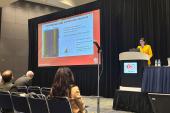Elderly ASCVD Patients Benefit From Aggressive LDL-Lowering With Evolocumab
Adding the PCSK9 inhibitor led to greater absolute reductions in CVD risk than in younger patients, with no signs of safety risk.

Elderly patients with atherosclerotic cardiovascular disease (ASCVD) treated long-term with the PCSK9 inhibitor evolocumab (Repatha; Amgen) derive as much clinical benefit as younger people, according to an analysis of the FOURIER trial and its open-label extension (OLE) study.
In fact, the absolute reduction in the primary endpoint—a composite of cardiovascular mortality, MI, stroke, hospitalization for unstable angina, or coronary revascularization—was larger in patients 75 years or older than in younger patients, and this translated into a smaller number needed to treat (NNT).
Senior investigator Robert Giugliano, MD (Brigham and Women’s Hospital, Boston, MA), said these data support “aggressive LDL-lowering in older patients,” just as is advised for those younger than 75 years. “There had been concerns in the past about LDL cholesterol being too low,” he told TCTMD. “Well, there doesn’t appear to be a floor with LDL. Lowest is best, and [this] applies in the elderly just as it does in younger patients.”
The most recent US guidelines for managing cholesterol recommend that physicians start a moderate- or high-dose statin in patients older than 75 years with ASCVD (class IIa, level of evidence B). The decision to start a statin should involve an evaluation of the potential benefits, adverse effects, and drug-drug interactions, as well as an assessment of patient frailty and preferences for treatment. The guidelines make no considerations for add-on therapies, such as ezetimibe or a PCSK9 inhibitor, in those ages 75 years and older.
“Historically, guidelines have been somewhat more cautious in their recommendations in older patients—arbitrarily we’ll say 75 and older—because of concerns about perhaps lesser benefit,” said Giugliano. “They’re older, they’re at risk for cancer and other illnesses that affect their lifespan.” Concerns about potentially worse side effects in an older cohort drive some of the cautiousness, too.
There doesn’t appear to be a floor with LDL. Lowest is best, and [this] applies in the elderly just as it does in younger patients. Robert Giugliano
Michael Nanna, MD (Yale University School of Medicine, New Haven, CT), who wasn’t involved in the study, said that older adults are at a higher risk of cardiovascular events than younger patients, yet they are far less likely to be optimally treated.
“The consistent message is that uptake of both high-intensity statins and some of the novel lipid-lowering agents is low, even in patients where the evidence for aggressive lipid-lowering is strong, such as patients with established ASCVD,” he told TCTMD. “We talk about this ‘treatment-risk paradox’ in older people with ASCVD, and it’s really a major barrier to what I would consider optimal care for these folks.”
At this stage, Nanna said, the data are fairly robust in terms of supporting the efficacy and safety of aggressive LDL-lowering in older patients, and he’d argue for the guidelines to be strengthened in this population. He also pointed to the stroke finding in this analysis, noting there was a significant interaction based on age. For those 75 years and older, evolocumab was associated with a significant reduction in stroke (HR 0.54; 95% CI 0.35-0.84), but no significant benefit was seen in younger patients (P = 0.021 for interaction).
“You can imagine how incredibly important that is for older people,” said Nanna. “Maintaining cognition and function is often their top health goal or priority.”
Larger Absolute Benefits in Elderly
The new analysis, which was published this week in the Journal of the American College of Cardiology, included 27,564 patients treated with evolocumab in the FOURIER randomized trial, of whom 2,596 patients were 75 years and older. Additionally, 6,635 patients were treated in the FOURIER-OLE study, with 531 of them aged 75 years and older. Older patients were more often female and more likely to have a history of hypertension, nonhemorrhagic stroke, and PAD, but less likely to smoke or have a history of MI. Median follow-up in FOURIER and FOURIER-OLE was 7.1 years.
Treatment with evolocumab in patients < 75 years reduced the absolute risk of the primary endpoint by 2.3% compared with placebo (HR 0.86; 95% CI 0.80-0.92) and by 5.4% in those 75 years and older (HR 0.79; 95% CI 0.64-0.97). Regarding the secondary endpoint, a composite of CVD death, MI, or stroke, the absolute reduction in risk in the younger and older age groups was 2.4% and 2.7%, respectively (HR 0.80; 95% CI 0.74-0.87 and HR 0.79; 95% CI 0.63-0.99, respectively).
The NNT to prevent one primary endpoint event was 19 in the older patients and 44 in those younger than 75 years. In the younger and older groups, the NNTs to prevent one CVD death, MI, or stroke were 37 and 42, respectively. The adverse event rate overall was higher in the older patients than in the younger group, but the annualized incidence of adverse events was slightly lower with evolocumab than with placebo in the older patients.
Giugliano said the study provides long-term safety and efficacy support for being more aggressive in older adults with ASCVD, noting the US population is aging and that many older adults are high functioning with significant years left to live.
“For those patients, why would you withhold therapy based on a number?” he asked. “There’s really no reason, at least in our experience with evolocumab, to withhold aggressive lipid-lowering therapy with a PCSK9 inhibitor. It probably does, in fact, apply to other therapies, but we didn’t study other therapies.”
Small Proportion of Older Adults Treated
In an accompanying editorial by Kalyani Dhar, MD (NYU Grossman School of Medicine, New York, NY), and colleagues, the group notes that only a small proportion of older adults receive optimal lipid-lowering therapy.
In one study, which was led by Nanna, researchers showed that less than 50% of patients 75 years and older with ASCVD received a statin and less than one in five received a high-intensity statin. Use of additional lipid-lowering agents was even lower, with less than 3% taking ezetimibe and only 0.2% on a PCSK9 inhibitor. More than 60% of these older adults had LDL levels exceeding 70 mg/dL.
This is despite evidence clearly showing that older adults benefit from lower LDL-cholesterol levels. In 2020, for example, a large meta-analysis of trials part of the Cholesterol Treatment Trialists’ Collaboration, along with five additional studies (Treat Stroke to Target, IMPROVE-IT, EWTOPIA 75, FOURIER, and ODYSSEY Outcomes), showed that lipid-lowering with statins and other agents was as effective in patients 75 years and older as it was in younger patients.
We talk about this ‘treatment-risk paradox’ in older people with ASCVD, and it’s really a major barrier to what I would consider optimal care for these folks. Michael Nanna
The reasons for the inadequate use of proven therapies in older patients is multifactorial, said Nanna, noting that clinical inertia may relate to perceptions of increased risk or attenuated benefit.
“What I think you see in this analysis is a resounding rebuttal of those misperceptions,” he said. There might also be a belief that patients won’t survive long enough to derive a benefit from treatment, but the average person who reaches 75 years lives for more than a decade, he added. “When you consider that most of the cardiovascular prevention trials are looking at a follow-up time far less than that, maybe 3 or 4 years, you can see there’s a huge opportunity for a preventive intervention in [older] people.”
Michael O’Riordan is the Managing Editor for TCTMD. He completed his undergraduate degrees at Queen’s University in Kingston, ON, and…
Read Full BioSources
Al Said S, O’Donoghue ML, Ran X, et al. Long-term lipid-lowering with evolocumab in older individuals. JACC. 2025;85:504-512.
Dhar K, Berger J, Newman J, et al. Evolocumab in older individuals: expanding the age horizon. _ JACC._ 2025;85:513-514.
Disclosures
- Giugliano reports research support from Amgen, Daiichi-Sankyo, and Ionis and honoraria for lectures from Amgen, Big Sky Cardiology, Daiichi-Sankyo, Dr Reddy’s Laboratories, Medical Education Resources, Pfizer, SUMMEET, and Vox Media. He reports consulting fees from Amgen, AstraZeneca, Daiichi-Sankyo, Inventiva, and Sanofi.
- Dhar and Nanna report no conflicts of interest.





Comments